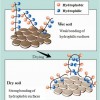 Water-repellent soils are unable to effectively adsorb or retain water. On these soils, water may simply pool on the surface or may move down preferred pathways, leaving large amounts of soil dry even when a large volume of water is applied. Thus, managing water and nutrients in sandy soils is often challenging. This 6-page fact sheet provides an overview of surfactants and how they may be used to better manage water and nutrients in sandy soils for vegetable and fruit production. Written by Guodong Liu, Monica Ozores-Hampton, Gene McAvoy, Ben Hogue, and Crystal A. Snodgrass, and published by the UF Department of Horticultural Sciences, October 2013.
Water-repellent soils are unable to effectively adsorb or retain water. On these soils, water may simply pool on the surface or may move down preferred pathways, leaving large amounts of soil dry even when a large volume of water is applied. Thus, managing water and nutrients in sandy soils is often challenging. This 6-page fact sheet provides an overview of surfactants and how they may be used to better manage water and nutrients in sandy soils for vegetable and fruit production. Written by Guodong Liu, Monica Ozores-Hampton, Gene McAvoy, Ben Hogue, and Crystal A. Snodgrass, and published by the UF Department of Horticultural Sciences, October 2013.
http://edis.ifas.ufl.edu/hs1230
Tag: Crystal Snodgrass
Managing Thrips and Tospoviruses in Tomato (ENY859/IN895)
 Several invasive species of thrips have established in Florida and are causing serious economic losses to vegetable, ornamental, and agronomic crops. Damage to crops results from thrips feeding and egg-laying injury, by the thrips vectoring of plant diseases, the cost of using control tactics, and the loss of pesticides due to resistance. This 12-page fact sheet describes the biology and ecology of thrips and tomato spotted wilt virus, and recommends a management program. Written by Joe Funderburk, Stuart Reitz, Steve Olson, Phil Stansly, Hugh Smith, Gene McAvoy, Ozan Demirozer, Crystal Snodgrass, Mathews Paret, and Norm Leppla, and published by the UF Department of Entomology and Nematology, August 2011.
Several invasive species of thrips have established in Florida and are causing serious economic losses to vegetable, ornamental, and agronomic crops. Damage to crops results from thrips feeding and egg-laying injury, by the thrips vectoring of plant diseases, the cost of using control tactics, and the loss of pesticides due to resistance. This 12-page fact sheet describes the biology and ecology of thrips and tomato spotted wilt virus, and recommends a management program. Written by Joe Funderburk, Stuart Reitz, Steve Olson, Phil Stansly, Hugh Smith, Gene McAvoy, Ozan Demirozer, Crystal Snodgrass, Mathews Paret, and Norm Leppla, and published by the UF Department of Entomology and Nematology, August 2011.
http://edis.ifas.ufl.edu/in895
Cultural Practices for Vegetable and Small Fruit Crops: Using Kaolin Clay to Reduce Sprinkler Irrigation for Strawberry Transplant Establishment (HS1188)
Because of the current limitations on water usage for strawberry growers in the Plant City area of Hillsborough County, researchers at the UF/IFAS Gulf Coast Research and Education center have been looking for inexpensive ways to reduce the amount of sprinkler irrigation in strawberry production. This 3-page fact sheet presents research results on the effect of kaolin clay application on sprinkler irrigation volumes applied to newly transplanted strawberries. It was written by Bielinski M. Santos, Teresa P. Salame-Donoso, Craig D. Stanley, Alicia J. Whidden, Crystal A. Snodgrass, and Mary B. Henry, and published by the UF Department of Horticultural Sciences, December 2010.
http://edis.ifas.ufl.edu/hs1188
HS1169 Maximizing the Efficacy of Soil Fumigant Applications for Raised Bed Plasticulture Systems of Florida
HS1169, a 5-page fact sheet by Andrew MacRae, Joseph Noling, and Crystal Snodgrass, describes several factors in crop production that should be considered to maximize the efficacy of alternatives to methyl bromide. Published by the UF Department of Horticultural Sciences, April 2010.
http://edis.ifas.ufl.edu/hs1169
HS1159 Estimating Copper, Manganese and Zinc Micronutrients in Fungicide Applications
HS1159, an 8-page fact sheet by Bee Ling Poh, Amanda Gevens, Eric Simonne, and Crystal Snodgrass, uses tomato as an example to list common sources of micronutrients in common fungicides, estimates micronutrient applications for an entire crop, and discusses the availability of these micronutrients so that the contributions of these sources of micronutrients can be factored in to the fertilizer programs for vegetable crops. Includes references. Published by the UF Department of Horticultural Sciences, August 2009.
http://edis.ifas.ufl.edu/HS1159